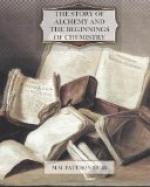[Illustration: FIG. XII. See p. 92.]
Besides discovering and recording many facts which have become part and parcel of the science of chemistry, the alchemists invented and used various pieces of apparatus, and conducted many operations, which are still employed in chemical laboratories. I shall reproduce illustrations of some of these processes and pieces of apparatus, and quote a few of the directions, given in a book, published in 1664, called The Art of Distillation, by John French, Dr. in Physick.
The method recommended by French for hermetically sealing the neck of a glass vessel is shown in Fig. VI. p. 80. The neck of the vessel is surrounded by a tray containing burning coals; when the glass melts it is cut off by shears, and then closed by tongs, which are made hot before use.
Fig. VII. p. 81, represents a method for covering an open vessel, air-tight, with a receptacle into which a substance may be sublimed from the lower vessel. The lettering explains the method of using the apparatus.
French gives very practical directions and much sound advice for conducting distillations of various kinds. The following are specimens of his directions and advice:—
“When you put water into a seething
Balneum wherein there are
glasses let it be hot, or else thou wilt
endanger the breaking of
the glasses.
“When thou takest any earthen, or
glass vessel from the fire,
expose it not to the cold aire too suddenly
for fear it should
break.
“In all your operations diligently observe the processes which you read, and vary not a little from them, for sometimes a small mistake or neglect spoils the whole operation, and frustrates your expectations.
“Try not at first experiments of
great cost, or great difficulty;
for it will be a great discouragement
to thee, and thou wilt be
very apt to mistake.




